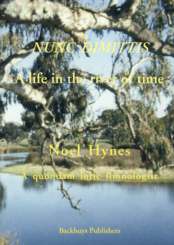

Noel Hynes abandoned his fishing gear in favour of a homemade bugnet when he was aged about eight and living near the Great Ouse River in England, and he never lost his fascination with the varied biota he was able to find in inland waters. At Imperial College of London University he was advised that entomology would be the best subject for him to study to accommodate his obsession, and when he graduated he was told that he would never get a job in his chosen field. However, he pursued it ardently, and in later life he has often described himself as an entomologist who went wrong. He worked on stoneflies for his doctorate, and that led him into the study of streams where most of them live, and after a fascinating period during the Second World War, working on locusts in eastern Africa, he returned to an academic post in England, where he could indulge his desire to find out more about running water. He has a good knowledge of western European languages, and this allowed him, with help from his multilingual mother, to read most of what had been written about the biology of rivers and streams; and he also became involved in the study of pollution which was widespread in Britain after the disruptions of war. In due course he wrote two books, one on water pollution and one reviewing the literature on stream ecology, and they encouraged and led to a great increase in studies of running water all over the planet. That caused Noel to be often called the father of running water ecology, especially in North America. This book is a very personal story of his life, dealing with his career, but without a great deal of scientific detail. It recounts his childhood through the rough period of the depression, his wide travels all over the planet, his courtship of his only true love, an excellent marriage that lasted 56 years, and many other matters arising from a long and fairly successful life through much of the difficult and dangerous 20th century. It should appeal to anyone with an interest in ecological studies as it records the development of a new field in aquatic biology, and traces the career of a scientist who was deeply involved in the process. It should also be an encouragement to young people who have a strong desire to pursue a line of work that is a bit out of the ordinary, by showing that perseverance can succeed. It is a very honest account of the life and thoughts of a now very senior scientist through a long, varied and interesting life that spanned several continents. That is because, after working for half an academic career in England, Noel took his family to Canada, where he now lives. And while based in Canada he spent two sabbatical years in Australia, taught in USA and Ethiopia, and worked also for the World Health Organization on the control of onchocerciasis in West Africa, the cause of river blindness which is carried by a biting fly that breeds in running water. It may also interest academic historians as describing life in a red brick university during the two decades after the war, and the formation of a successful department of biology in a brand new Canadian university during the sixties.
It was written primarily for the general reader, not the scientist, but access to details of the science involved is given in the list of publications.